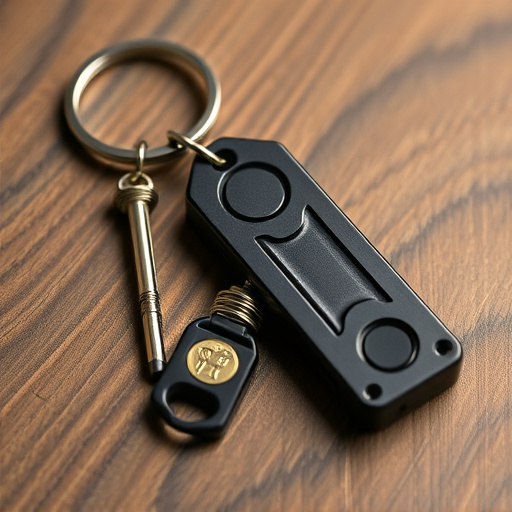The legal status of keychain self-defense pressure targets varies globally, with each region imposing unique regulations on their design, use, and possession. These devices fall under broader self-defense legislation, requiring compliance with safety standards, including limited lethality and specific labeling requirements. Users and manufacturers must navigate regional weapon possession guidelines, ensuring products meet mechanical property mandates and include approved test reports. Comprehensive research of local laws is essential for safe and legal use, emphasizing the need for collaboration between manufacturers and users to maintain optimal safety standards.
In today’s world, personal safety is paramount. Keychain self-defense devices, particularly those with pressure targets, have gained popularity as quick, portable protection tools. This article delves into the legal landscape surrounding these devices, offering a comprehensive checklist for users and manufacturers alike. We explore key components of legal requirements, state-by-state regulations, and best practices to ensure safety and compliance, empowering individuals to make informed decisions about keychain self-defense pressure targets.
- Understanding Keychain Self-Defense Devices: A Legal Perspective
- Key Components of Legal Requirements for Pressure Target Keychains
- State and Regional Regulations: A Comprehensive Check
- Ensuring Safety and Compliance: Best Practices for Manufacturers and Users
Understanding Keychain Self-Defense Devices: A Legal Perspective
Keychain self-defense devices, such as pressure targets designed for personal safety, operate under a legal framework that varies significantly across jurisdictions. Understanding these legal requirements is essential to ensure the product’s compliance and its users’ safety. In many regions, these devices are regulated under broader self-defense legislation, which often includes guidelines on what constitutes a legal self-defense tool, its design, and intended use.
Keychain pressure targets must meet specific criteria to be classified as lawful self-defense items. This typically involves features like limited lethality, designed for non-lethal force, and compliance with local guidelines on weapon possession. The legal perspective also considers the context in which these devices are employed—self-defense scenarios versus offensive uses—to determine their viability and acceptability under existing laws.
Key Components of Legal Requirements for Pressure Target Keychains
The legal landscape surrounding keychain self-defense pressure targets is a crucial consideration for manufacturers and users alike. Several key components define the requirements, ensuring both safety and legality. One of the primary aspects is compliance with relevant regulations on weapons and self-defense devices. These laws vary by jurisdiction but often dictate materials, design standards, and functionality. For instance, many regions mandate specific mechanical properties to prevent accidental discharge or unauthorized use.
Additionally, labeling and packaging play a vital role in legal adherence. Clear instructions, safety warnings, and appropriate signage are essential components. The information must educate users on safe handling practices, potential risks, and any necessary precautions. Moreover, the inclusion of approved test reports or certifications from recognized laboratories can bolster the device’s legality and reliability. Such measures collectively contribute to a robust framework governing keychain self-defense pressure targets, prioritizing both personal safety and legal accountability.
State and Regional Regulations: A Comprehensive Check
When it comes to keychain self-defense pressure targets, understanding State and Regional Regulations is paramount. Each jurisdiction has its own set of laws governing self-defense devices, and what might be legal in one place could be strictly prohibited elsewhere. This includes regulations on the type of force allowed, carrying restrictions, and even the design and functionality of self-defense tools like keychain pressure targets.
A comprehensive check should involve researching local, state, and regional laws to ensure compliance. This means understanding not only the general rules around self-defense but also any specific requirements for carrying and using devices like keychain pressure targets. Staying informed about these regulations is crucial to avoid legal repercussions and to confidently exercise your right to personal safety.
Ensuring Safety and Compliance: Best Practices for Manufacturers and Users
Ensuring safety and compliance is paramount when dealing with keychain self-defense pressure targets, a unique product category that requires careful consideration of both design and user guidelines. Manufacturers play a crucial role in upholding safety standards by implementing best practices during production. This includes rigorous testing to ensure the target’s integrity under stress, proper material selection for durability and non-harmful components, and clear, comprehensive instructions for users.
Users, too, have responsibilities to uphold. They should familiarize themselves with the product’s limitations and safety features, follow manufacturer guidelines meticulously, and store the keychain target in a secure location when not in use. Regular maintenance checks can also help identify potential issues early on, enhancing overall safety.
In conclusion, navigating the legal landscape surrounding keychain self-defense devices, specifically pressure target keychains, is essential for both manufacturers and users. Understanding state and regional regulations, as well as best practices for safety and compliance, ensures that these tools can be utilized effectively while adhering to legal requirements. By staying informed about the key components of legal guidelines, individuals and businesses can contribute to a safer environment, promoting the responsible use of keychain self-defense pressure targets.
